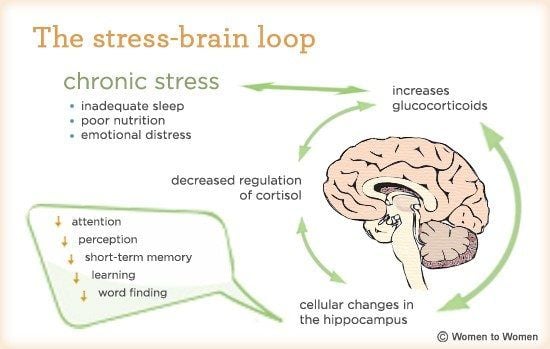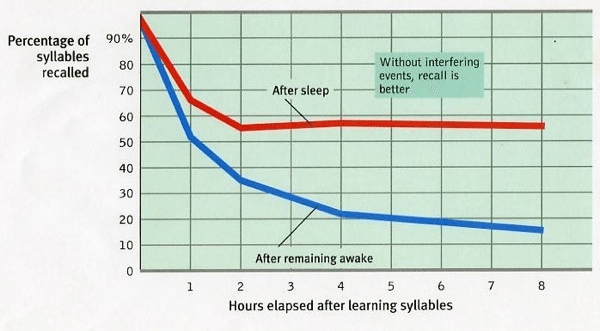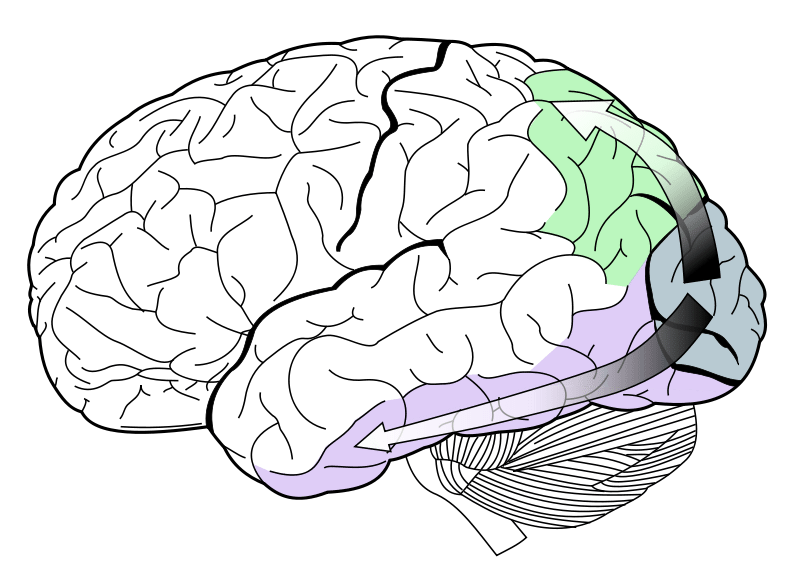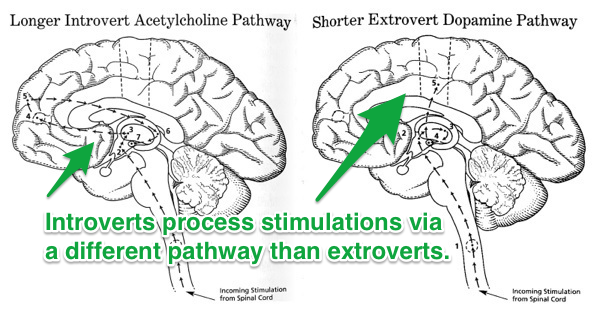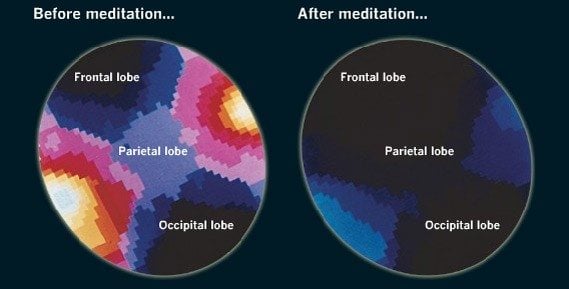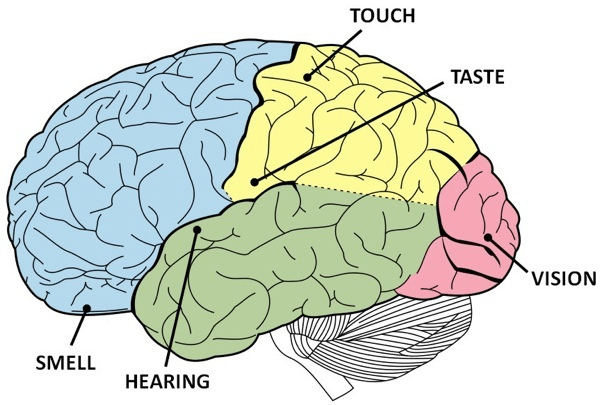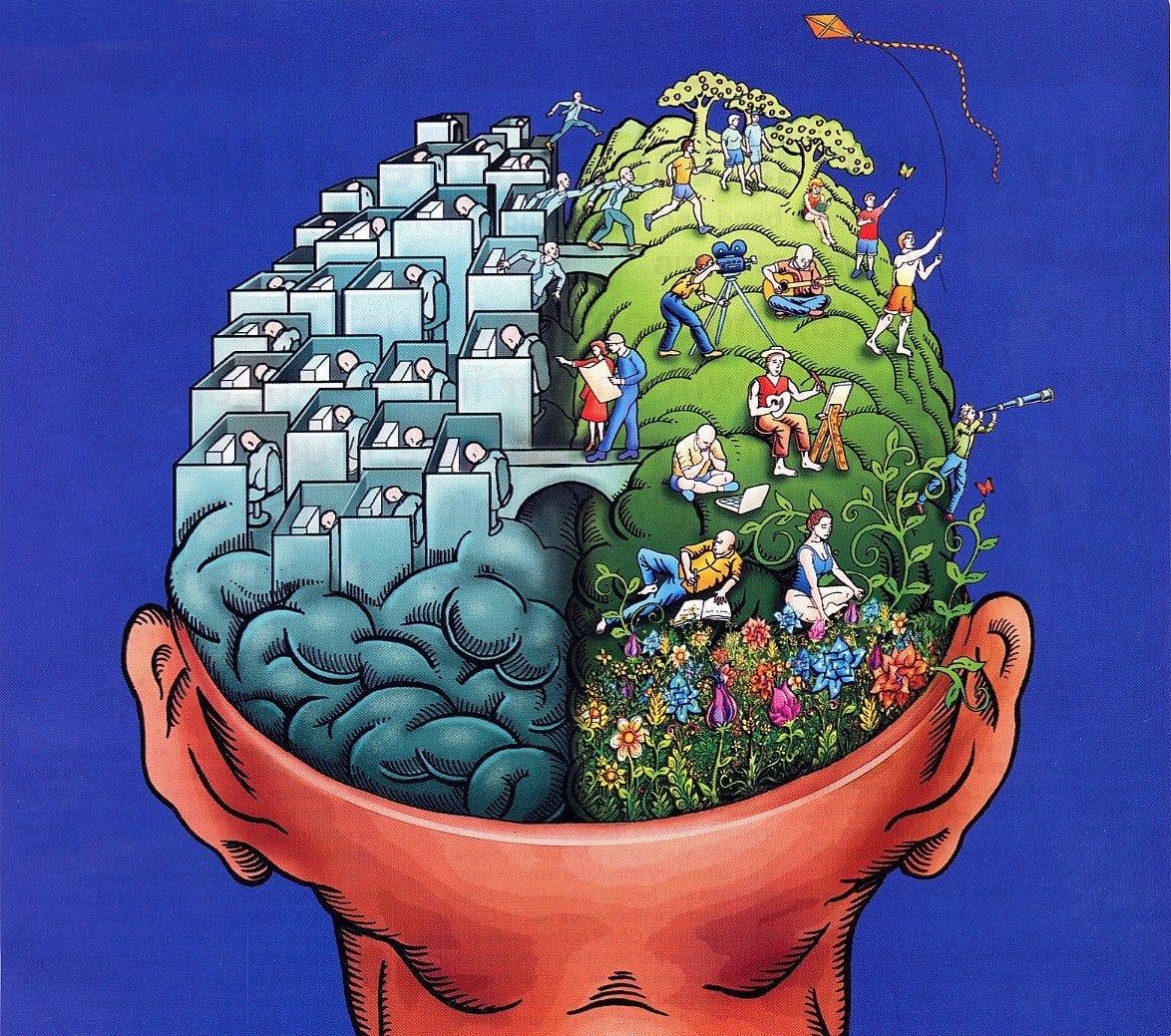
One of the things that surprises me time and time again is how we think our brains work and how they actually do.
On many occasions I find myself convinced that there is a certain way to do things, only to find out that actually that’s the complete wrong way to think about it. For example, I always found it fairly understandable that we can multitask. Well, according to the latest research studies, it’s literally impossible for our brains to handle 2 tasks at the same time.
Recently I came across more of these fascinating experiments and ideas that helped a ton to adjust my workflow towards how our brains actually work (instead of what I thought!).
So here are 10 of the most surprising things our brain does and what we can learn from it:
1. Your brain does creative work better when you’re tired
When I explored the science of our body clocks and how they affect our daily routines, I was interested to find that a lot of the way I’d planned my days wasn’t really the best way to go about it. The way we work, in particular, actually has a lot to do with the cycles of our body clocks.
Here’s how it breaks down:
If you’re a morning lark, say, you’ll want to favor those morning hours when you’re feeling more fresh to get your most demanding, analytic work done. Using your brain to solve problems, answer questions and make decisions is best done when you’re at your peak
For night owls, this is obviously a much later period in the day.
On the other hand, if you’re trying to do creative work, you’ll actually have more luck when you’re more tired and your brain isn’t functioning as efficiently. This sounds crazy, but it actually makes sense when you look at the reasoning behind it. It’s one of the reasons why great ideas often happen in the shower after a long day of work.
If you’re tired, your brain is not as good at filtering out distractions and focusing on a particular task. It’s also a lot less efficient at remembering connections between ideas or concepts. These are both good things when it comes to creative work, since this kind of work requires us to make new connections, be open to new ideas and think in new ways. So a tired, fuzzy brain is much more use to us when working on creative projects.
This Scientific American article explains how distractions can actually be a good thing for creative thinking:
Insight problems involve thinking outside the box. This is where susceptibility to “distraction” can be of benefit. At off-peak times we are less focused, and may consider a broader range of information. This wider scope gives us access to more alternatives and diverse interpretations, thus fostering innovation and insight.
2. Stress can change the size of your brain (and make it smaller)
I bet you didn’t know stress is actually the most common cause of changes in brain function. I was surprised to find this out when I looked into how stress affects our brains.
I also found some research that showed signs of brain size decreasing due to stress.
One study used baby monkeys to test the effects of stress on development and long-term mental health. Half the monkeys were cared for by their peers for 6 months while the other half remained with their mothers. Afterwards, the monkeys were returned to typical social groups for several months before the researchers scanned their brains.
For the monkeys who had been removed from their mothers and cared for by their peers, areas of their brains related to stress were still enlarged, even after being in normal social conditions for several months.
Although more studies are needed to explore this fully, it’s pretty scary to think that prolonged stress could affect our brains long-term.
Another study found that in rats who were exposed to chronic stress, the hippocampuses in their brains actually shrank. The hippocampus is integral to forming memories. It has been debated before whether Post Traumatic Stress Disorder (PTSD) can actually shrink the hippocampus, or people with naturally smaller hippocampuses are just more prone to PTSD. This study could point to the stress being a factor in actually changing the brain.
3. It is literally impossible for our brains to multi-task
Multi-tasking is something we’ve long been encouraged to practice, but it turns out multitasking is actually impossible. When we think we’re multi-tasking, we’re actually context-switching. That is, we’re quickly switching back-and-forth between different tasks, rather than doing them at the same time.
The book Brain Rules explains how detrimental “multi-tasking” can be:
Research shows your error rate goes up 50 percent and it takes you twice as long to do things.
The problem with multi-tasking is that we’re splitting our brain’s resources. We’re giving less attention to each task, and probably performing worse on all of them:
When the brain tries to do two things at once, it divides and conquers, dedicating one-half of our gray matter to each task.
Here is how this looks like in reality. Whilst we try to do both Action A and Action B at the same time, our brain is never handling both simultaneously. Instead, it has to painfully switch back and forth and use important brainpower just for the switching:

When our brains handle a single task, the prefrontal cortex plays a big part. Here’s how it helps us achieve a goal or complete a task:
The anterior part of this brain region forms the goal or intention—for example, “I want that cookie”—and the posterior prefrontal cortex talks to the rest of the brain so that your hand reaches toward the cookie jar and your mind knows whether you have the cookie.
A study in Paris found that when a second task was required, the brains of the study volunteers split up, with each hemisphere working alone on a task. The brain was overloaded by the second task and couldn’t perform at its full capacity, because it needed to split its resources.
When a third task was added, the volunteers’ results plummeted:
The triple-task jugglers consistently forgot one of their tasks. They also made three times as many errors as they did while dual-tasking.
4. Naps improve your brain’s day to day performance
We’re pretty clear on how important sleep is for our brains, but what about naps? It turns out, these short bursts of sleep are actually really useful.
Here are a couple of ways napping can benefit the brain:
Improved memory
In one study, participants memorized illustrated cards to test their memory strength. After memorizing a set of cards, they had a 40-minute break wherein one group napped, and the other stayed awake. After the break both groups were tested on their memory of the cards, and the group who had napped performed better:
Much to the surprise of the researchers, the sleep group performed significantly better, retaining on average 85 percent of the patterns, compared to 60 percent for those who had remained awake.
Apparently, napping actually helps our brain to solidify memories:
Research indicates that whena memory is first recorded in the brain—in the hippocampus, to be specific—it’s still “fragile” and easily forgotten, especially if the brain is asked to memorize more things. Napping, it seems, pushes memories to the neocortex, the brain’s “more permanent storage,” preventing them from being “overwritten.”
Let’s look at that in a graph – the people who took a nap, were able to wildly outperform those who didn’t. It’s like they had a fresh start:
Better learning
Taking a nap also helps to clear information out of your brain’s temporary storage areas, getting it ready for new information to be absorbed. A study from the University of California asked participants to complete a challenging task around midday, which required them to take in a lot of new information. At around 2p.m., half of the volunteers took a nap while the rest stayed awake.
The really interesting part of this study is not only that at 6p.m. that night the napping group performed better than those who didn’t take a nap. In fact, the napping group actually performed better than they had earlier in the morning.
What happens in the brain during a nap
Some recent research has found that the right side of the brain is far more active during a nap than the left side, which stays fairly quiet while we’re asleep. Despite the fact that 95% of the population is right-handed, with the left side of their brains being the most dominant, the right side is consistently the more active hemisphere during sleep.
The study’s author, Andrei Medvedev, speculated that the right side of the brain handles ‘housekeeping’ duties while we’re asleep.
So while the left side of your brain takes some time off to relax, the right side is clearing out your temporary storage areas, pushing information into long-term storage and solidifying your memories from the day.
5. Your vision trumps all other senses
Despite being one of our five main senses, vision seems to take precedence over the others:
Hear a piece of information, and three days later you’ll remember 10 percent of it. Add a picture and you’ll remember 65 percent.
Pictures beat text as well, in part because reading is so inefficient for us. Our brain sees words as lots of tiny pictures, and we have to identify certain features in the letters to be able to read them. That takes time.
In fact, vision is so powerful that the best wine tasters in the world have been known to describe a dyed white wine as a red.
Not only is it surprising that we rely on our vision so much, but it actually isn’t even that good! Take this fact, for instance:
Our brain is doing all this guessing because it doesn’t know where things are. In a three-dimensional world, the light actually falls on our retina in a two-dimensional fashion. So our brain approximates viewable image.
Let’s look at this image. It shows you how much of your brain is dedicated just to vision and how it affects other parts of the brain. It’s a truly staggering amount, compared to any other areas:
6. Introversion and extroversion come from different wiring in the brain
I just recently realized that introversion and extroversion are not actually related to how outgoing or shy we are, but rather how our brains recharge.
Here’s how the brains of introverts and extroverts differ:
Research has actually found that there is a difference in the brains of extroverted and introverted people in terms of how we process rewards and how our genetic makeup differs. For extroverts, their brains respond more strongly when a gamble pays off. Part of this is simply genetic, but it’s partly the difference of their dopamine systems as well.
An experiment that had people take gambles while in a brain scanner found the following:
When the gambles they took paid off, the more extroverted group showed a stronger response in two crucial brain regions: the amygdala and the nucleus accumbens.
The nucleus accumbens is part of the dopamine system, which affects how we learn, and is generally known for motivating us to search for rewards. The difference in the dopamine system in the extrovert’s brain tends to push them towards seeking out novelty, taking risks and enjoying unfamiliar or surprising situations more than others. The amygdala is responsible for processing emotional stimuli, which gives extroverts that rush of excitement when they try something highly stimulating which might overwhelm an introvert.
More research has actually shown that the difference comes from how introverts and extroverts process stimuli. That is, the stimulation coming into our brains is processed differently depending on your personality. For extroverts, the pathway is much shorter. It runs through an area where taste, touch, visual and auditory sensory processing takes place. For introverts, stimuli runs through a long, complicated pathway in areas of the brain associated with remembering, planning and solving problems.
7. We tend to like people who make mistakes more
Apparently, making mistakes actually makes us more likeable, due to something called the Pratfall Effect.
Kevan Lee recently explained how this works on the Buffer blog:
Those who never make mistakes are perceived as less likeable than those who commit the occasional faux pas. Messing up draws people closer to you, makes you more human. Perfection creates distance and an unattractive air of invincibility. Those of us with flaws win out every time.
This theory was tested by psychologist Elliot Aronson. In his test, he asked participants to listen to recordings of people answering a quiz. Select recordings included the sound of the person knocking over a cup of coffee. When participants were asked to rate the quizzers on likability, the coffee-spill group came out on top.
So this is why we tend to dislike people who seem perfect! And now we know that making minor mistakes isn’t the worst thing in the world—in fact, it can work in our favor.
8. Meditation can rewire your brain for the better
Here’s another one that really surprised me. I thought meditation was only good for improving focus and helping me to stay calm throughout the day, but it actually has a whole bunch of great benefits.
Here are a few examples:
Less anxiety
This point is pretty technical, but it’s really interesting. The more we meditate, the less anxiety we have, and it turns out this is because we’re actually loosening the connections of particular neural pathways. This sounds bad, but it’s not.
What happens without meditation is that there’s a section of our brains that’s sometimes called the Me Center (it’s technically the medial prefrontal cortex). This is the part that processes information relating to ourselves and our experiences. Normally the neural pathways from the bodily sensation and fear centers of the brain to the Me Center are really strong. When you experience a scary or upsetting sensation, it triggers a strong reaction in your Me Center, making you feel scared and under attack.
Here is how anxiety and agitation decreases with just a 20 minute meditation session:
When we meditate, especially when we are just getting started with meditation, we weaken this neural connection. This means that we don’t react as strongly to sensations that might have once lit up our Me Centers. As we weaken this connection, we simultaneously strengthen the connection between what’s known as our Assessment Center (the part of our brains known for reasoning) and our bodily sensation and fear centers. So when we experience scary or upsetting sensations, we can more easily look at them rationally. Here’s a good example:
For example, when you experience pain, rather than becoming anxious and assuming it means something is wrong with you, you can watch the pain rise and fall without becoming ensnared in a story about what it might mean.
More creativity
Researchers at Leiden University in the Netherlands studied both focused-attention and open-monitoring mediation to see if there was any improvement in creativity afterwards. They found that people who practiced focused-attention meditation did not show any obvious signs of improvement in the creativity task following their meditation. For those who did open-monitoring meditation, however, they performed better on a task that asked them to come up with new ideas.
Better memory
One of the things meditation has been linked to is improving rapid memory recall. Catherine Kerr, a researcher at the Martinos Center for Biomedical Imaging and the Osher Research Center found that people who practiced mindful meditation were able to adjust the brain wave that screens out distractions and increase their productivity more quickly that those that did not meditate. She said that this ability to ignore distractions could explain “their superior ability to rapidly remember and incorporate new facts.” This seems to be very similar to the power of being exposed to new situations that will also dramatically improve our memory of things.
Meditation has also been linked to increasing compassion, decreasing stress, improving memory skills and even increasing the amount of gray matter in the brain.
9. Exercise can reorganize the brain and boost your willpower
Sure, exercise is good for your body, but what about your brain? Well apparently there’s a link between exercise and mental alertness, in a similar way that happiness and exercise are related.
A lifetime of exercise can result in a sometimes astonishing elevation in cognitive performance, compared with those who are sedentary. Exercisers outperform couch potatoes in tests that measure long-term memory, reasoning, attention, problem-solving, even so-called fluid-intelligence tasks.
Of course, exercise can also make us happier, as we’ve explored before:
If you start exercising, your brain recognizes this as a moment of stress. As your heart pressure increases, the brain thinks you are either fighting the enemy or fleeing from it. To protect yourself and your brain from stress, you release a protein called BDNF (Brain-Derived Neurotrophic Factor). This BDNF has a protective and also reparative element to your memory neurons and acts as a reset switch. That’s why we often feel so at ease and things are clear after exercising and eventually happy.
At the same time, endorphins, another chemical to fight stress, are released in your brain. The main purpose of endorphis is this, writes researcher McGovern:
These endorphins tend to minimize the discomfort of exercise, block the feeling of pain and are even associated with a feeling of euphoria.
10. You can make your brain think time is going slowly by doing new things
Ever wished you didn’t find yourself saying “Where does the time go!” every June when you realize the year is half-over? This is a neat trick that relates to how our brains perceive time. Once you know how it works, you can trick your brain into thinking time is moving more slowly.
Essentially, our brains take a whole bunch of information from our senses and organize it in a way that makes sense to us, before we ever perceive it. So what we think is our sense of time is actually just a whole bunch of information presented to us in a particular way, as determined by our brains:
When our brains receive new information, it doesn’t necessarily come in the proper order. This information needs to be reorganized and presented to us in a form we understand. When familiar information is processed, this doesn’t take much time at all. New information, however, is a bit slower and makes time feel elongated.
Even stranger, it isn’t just a single area of the brain that controls our time perception—it’s done by a whole bunch of brain areas, unlike our common five senses, which can each be pinpointed to a single, specific area.
When we receive lots of new information, it takes our brains a while to process it all. The longer this processing takes, the longer that period of time feels:
When we’re in life-threatening situations, for instance, “we remember the time as longer because we record more of the experience. Life-threatening experiences make us really pay attention, but we don’t gain superhuman powers of perception.”
The same thing happens when we hear enjoyable music, because “greater attention leads to perception of a longer period of time.”
Conversely, if your brain doesn’t have to process lots of new information, time seems to move faster, so the same amount of time will actually feel shorter than it would otherwise. This happens when you take in lots of information that’s familiar, because you’ve processed it before. Your brain doesn’t have to work very hard, so it processes time faster.
Do you have another surprising fact about the brain you’d like to share? I’d love to hear it! If you enjoyed this post, I think you might also like our post about 10 Simple Things You Can Do Today That Will Make You Happier, Backed By Science.
Try Buffer for free
140,000+ small businesses like yours use Buffer to build their brand on social media every month
Get started nowRelated Articles
We’ve written about creativity a few times on the Buffer blog, but it’s hard to keep track of everything we learn about it. One day I’m adjusting the temperature in my workspace, and the next I’m trying to put off creative work until I’m tired. If you’re in the same boat, and you find it’s difficult to remember what will improve your creativity and when you should do your most creative work, hopefully this list will help you get it all straight. 1. Your brain does better creative work when yo
I’ve noticed that the way I spend my lunch break affects how productive I am for the rest of the day: how quickly I get started once I get back to my desk, how effective I am in the first hour after lunch, and how I feel throughout the afternoon. Luckily, we’ve been writing about ways to improve your day for a while now: from tips on making your environment more conducive to creativity to pushing through writer’s block. Why shouldn’t the humble lunch break get the same treatment? I gathered th
Constraints can seem like the last thing you’d want for a creative project, but they’re actually beneficial when it comes to doing good work. If you’ve ever faced the common writer’s hurdle of the blank page, you’ll know what it’s like to be paralyzed by innumerable opportunities. What restrictions do is take away some of the choices available to us, and with them, the paralysis of choice that stops us from getting started. We love trying things that seem counterintuitive at Buffer, but we espe
